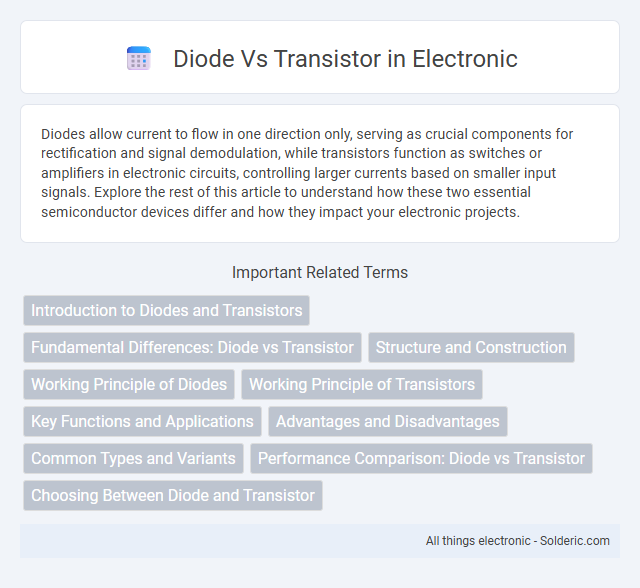Diodes allow current to flow in one direction only, serving as crucial components for rectification and signal demodulation, while transistors function as switches or amplifiers in electronic circuits, controlling larger currents based on smaller input signals. Explore the rest of this article to understand how these two essential semiconductor devices differ and how they impact your electronic projects.
Comparison Table
| Feature | Diode | Transistor |
|---|---|---|
| Function | Allows current flow in one direction (rectification) | Amplifies or switches electronic signals |
| Type | Two-terminal semiconductor device | Three-terminal semiconductor device |
| Terminals | Anode and Cathode | Emitter, Base, Collector |
| Operation | Forward biased: conducts; Reverse biased: blocks current | Controlled by base current or voltage to regulate collector-emitter current |
| Applications | Rectifiers, voltage clamping, signal demodulation | Amplifiers, switches, oscillators, digital circuits |
| Types | PN Junction, Zener, Schottky, Light Emitting Diode (LED) | Bipolar Junction Transistor (BJT), Field Effect Transistor (FET) |
| Symbol | Arrow indicating current direction | Arrow on emitter showing electron flow |
| Current Control | No control terminal; current flows based on biasing | Current or voltage at base/gate controls larger current flow |
| Power Handling | Generally lower power compared to transistors | Handles higher power and current in amplification and switching |
Introduction to Diodes and Transistors
Diodes are semiconductor devices that primarily allow current to flow in one direction, acting as a one-way valve essential for rectification and signal modulation. Transistors are three-terminal semiconductor devices used to amplify or switch electronic signals, functioning as the fundamental building blocks of modern electronic circuits. Both diodes and transistors are made from materials like silicon and gallium arsenide, with their unique structures enabling distinct roles in controlling electrical currents.
Fundamental Differences: Diode vs Transistor
A diode is a two-terminal semiconductor device that allows current to flow primarily in one direction, acting as a rectifier. In contrast, a transistor is a three-terminal device used for amplification and switching, controlling current flow between its terminals via a small input signal. The fundamental difference lies in their operation: diodes enable unidirectional current flow while transistors regulate larger currents through controlled inputs.
Structure and Construction
A diode consists of a single p-n junction formed by joining p-type and n-type semiconductor materials, creating a simple two-layer structure that allows current to flow in one direction. A transistor, such as a bipolar junction transistor (BJT), has a more complex structure with three layers of alternating p-type and n-type materials (emitter, base, and collector) enabling amplification and switching functions. Understanding the construction differences helps you choose the right semiconductor device for circuits requiring rectification or amplification.
Working Principle of Diodes
Diodes operate based on the principle of allowing current to flow in only one direction through a semiconductor p-n junction, creating a unidirectional current path. When forward-biased, the diode's p-type and n-type regions permit electron flow, resulting in current conduction, while in reverse bias, the junction prevents current flow due to the widening depletion region. This fundamental property distinguishes diodes from transistors, which control current flow through additional semiconductor layers and junctions for amplification or switching.
Working Principle of Transistors
Transistors operate based on the principle of controlling current flow through semiconductor materials using a small input voltage or current applied to the base terminal, which modulates the larger current between the collector and emitter terminals. This amplification capability allows transistors to function as switches or signal amplifiers in electronic circuits. Unlike diodes, which allow current flow primarily in one direction, transistors enable precise control of electrical signals, making them fundamental components in modern electronics.
Key Functions and Applications
Diodes primarily function as one-way electrical valves, allowing current to flow in a single direction and are widely used in rectification, signal clipping, and voltage regulation. Transistors serve as electronic switches or amplifiers, controlling current flow and enabling signal amplification in circuits such as audio devices, digital logic, and power regulation. Understanding the distinct roles of these components helps optimize your electronic design for efficient signal control and amplification.
Advantages and Disadvantages
Diodes offer the advantage of simple construction, fast switching speeds, and efficient current flow in one direction, making them ideal for rectification and signal clipping but are limited by their inability to amplify signals. Transistors provide significant benefits including current amplification, switching capabilities, and versatility in analog and digital circuits, yet they require more complex biasing and can generate more heat, impacting reliability. Your choice depends on whether the application demands unidirectional current control or signal amplification, balancing simplicity against functionality.
Common Types and Variants
Common types of diodes include the standard silicon diode, Zener diode used for voltage regulation, Schottky diode known for its low forward voltage drop, and light-emitting diode (LED) that emits light when forward biased. Transistor variants primarily consist of bipolar junction transistors (BJTs) with NPN and PNP types, and field-effect transistors (FETs), including MOSFETs, which are widely used in switching and amplification applications. Both components have specialized forms, such as photodiodes for light detection and power transistors for high-current handling, reflecting their diverse roles in electronic circuits.
Performance Comparison: Diode vs Transistor
Diodes and transistors serve distinct functions in electronic circuits, with diodes primarily allowing current flow in one direction and transistors enabling amplification and switching. Transistors generally offer superior performance in controlling current with higher gain and faster switching speeds compared to diodes. Your choice between a diode and a transistor should consider factors such as signal amplification needs, switching speed requirements, and power handling capabilities.
Choosing Between Diode and Transistor
Choosing between a diode and a transistor depends on the specific electronic circuit requirements, such as signal control or current amplification. Diodes are ideal for directing current flow and rectification tasks, while transistors are essential for switching and amplification functions. Evaluating the application's need for stability, gain, or simple directional current flow guides the optimal component selection.
Diode vs Transistor Infographic

 solderic.com
solderic.com